

FOA Recognizes It's Master Instructors Google Chooses KC For GB FTTH How Fast Is Data Traffic Growing? Facebook Opens New Energy Efficient Data Center The World's Biggest Data Centers Fiber + Power = Cell Phone Tower New @ FOA FOA Corporate Memberships Fiber U - two new free online self-study courses Publications: NECA/FOA 301 Installation Revised, eBooks Online Reference Guide: New pages on BI fiber, data centers, more Tech Topics: More online information Certification: New FOA OSP Certification FOA Schools: New schools and programs FOA Jobs Web Site
Fiber U is back - at the OSP Expo Q&A: Large number of good questions this month. Product News - Tiny splicer, more bend insensitive fibers, Surplus fiber offered Worth Reading: More interesting things we've read (and videos we've seen.)
|
It's now CFOT® and Fiber U® The FOA CFOT® (Certified Fiber Optic Technician) and Fiber U® (the FOA online self-study program) are now a registered trademark. With over 33,000 fiber optic techs holding CFOTs and the CFOT being recognized worldwide as the foremost certification in fiber optics, the FOA realized the value of the CFOT and Fiber U required trademark protection. Now it's official! Want to know more about fiber optics? Free Self-Study Program on "Fiber U®." Looking for specific information? Study for FOA certifications? Here's the largest technical reference on the web: The FOA Online Fiber Optic Reference Guide. New FOA Reference Books(Available Printed or eBooks)
|
| Renew your FOA certification online - plus get a discount coupon for the new FOA books and get an extra month free. Details here. |
FOA To Present Seminars in Africa in May Come meet the FOA in Johannesburg, Nairobi and Lusaka and learn what's new in fiber optics! 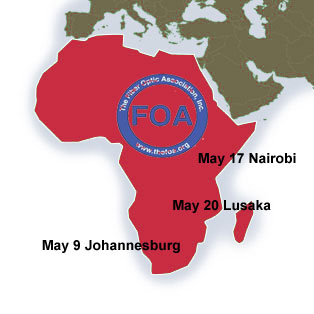 The FOA seminar series on "State of the Art in Fiber Optics" is coming to South Africa, Kenya and Zambia this Spring. We'll be in Johannesburg on May 9, Nairobi, Kenya on May 17 (World Telecom Day) and Lusaka, Zambia May 20. Africa is one of the fastest growing regions for fiber optics as countries there build out their communications infrastructures. FOA has schools that are active in training the personnel responsible for building many of these networks so we're coming to their countries with our "state of the art" seminar series. If you are in the region, you are invited to come meet FOA President Jim Hayes and Adminstrative Director Karen Hayes, hear about the latest fiber optic technology and FOA programs to support the growth of fiber optics. Agenda Welcome by local FOA School Personnel Recognition of local attendees Introduction of the FOA and its programs Presentation “The State of the Art in Fiber Optics” Fiber optics has become the backbone of the world’s communications systems. It connects the world on land and undersea cables, providing high speed, inexpensive communications for voice, data, and video. Besides the obvious applications, fiber has many other uses, for example connecting wireless systems, data centers, even automating the electrical grid. This presentation will cover some new applications for fiber optics and some new fiber optic components that facilitate these applications. Here are the dates, locations and sponsoring schools: Johannesburg on May 9, Triple Play Fibre Optic Solutions Nairobi, Kenya on May 17, African eDevelopment Resource Centre Lusaka, Zambia May 20, ICT Resources Center Attendance is limited. Contact the local FOA-Approved School for details on the seminars. FOA Recognizes It's Master Instructors FOA training and certification has become the world standard for creating the workforce needed to permit the rapid expansion of communications worldwide. Part of this comes from all the technical information and curriculum we develop and make available on our website and through our schools. Part of it comes from our schools themselves, as we only allow the best to become "FOA-Approved." But most of all, it is a result of the instructors who teach these FOA certification courses. 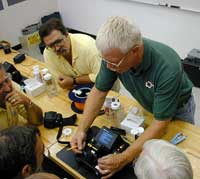 Master Instructors Tom Collins (L, current FOA Board Member, and John Highhouse, Former President of the FOA, emeritus) teaching an FOA train-the-trainer course. Some of our instructors have more than 30 years experience in the business. Some participated in the earliest applications where fiber optic systems were installed commercially. Some have been instrumental in developing the technology and components that have made fiber optic communications grow so fast. Many have been developing courses and teaching for decades. Many are still actively involved in designing and installing systems. All share a love for teaching and a talent to pass their knowledge and experience along to their students. The FOA is recognizing those outstanding instructors who have served the fiber optic industry and the FOA so well by designating them as “FOA Master Instructors.” These instructors have been an extremely important influence on our industry in helping create a capable workforce that has helped make fiber optic communications so successful. The designation “FOA Master Instructor” recognizes their contribution to our industry. Those honored this year as FOA Master Instructors include Wallace Allen, Bob Ballard, Joe Botha, Craig Bowd, Tom Collins, Mike DiMauro, Pat Dobbins, Tom Dowdy, Craig Getchel, Gary Giguere, Mark Goodwin-Asire, Bill Graham, Arnie Harris, John Highhouse (emeritus), Chris Hillyer, Robert Kinney, Dave Miller, Peter Morcombe, Milt Murry, Terry O’Malley, Eric Pearson, Bill Pruett, Eric Quinby, Tom Rauch, Dominick Tambone Jim Underwood, Chuck Vella and Leonard Wasser. Google Chooses Kansas City For GB FTTH Over a year after announcing they wanted to build a showcase gigabit/second FTTH network, Google has announced they will build that network in Kansas City, Kansas. KC is the first site selected by the company's project to spur development of a new generation of Web applications. Google announced in February 2010 their intention to build a series of experimental ultra-high-speed networks in various cities across the United States. Google said the goal of building the networks was to test ways to create new Web services, as well as new ways to build fiber networks. Google said it has signed a development agreement with Kansas City and expects to begin offering service in 2012, pending approval from the city's board of commissioners. "Over the past decade, the jump from dial-up to broadband has led to streaming online video, digital music sales, video conferencing over the web and countless other innovations that have transformed communication and commerce. We can’t wait to see what new products and services will emerge as Kansas City moves from traditional broadband to ultra high-speed fiber optic connections." Google said in its announcement on its blog. KC may not be the only city to benefit from this program, good news to the other 1100 cities vying for Google's network. Google said it would look closely at ways to bring high speed Internet access to other cities across the country. How Fast Is Data Traffic Growing? A new report from IGI, “North American Network Traffic Forecast 2011,” by Clifford Holliday, provides detailed telecommunications forecasts for North America thorough 2016. This latest report forecasts an astounding 100 Exabytes of traffic on the North American network by 2016. Many changes have occurred that dramatically impact the nature of network traffic. These changes, which are fully considered in this new report, include the following: The dramatic rise in traffic from advanced access architecture (AAA) lines (FTTP and FTTN); 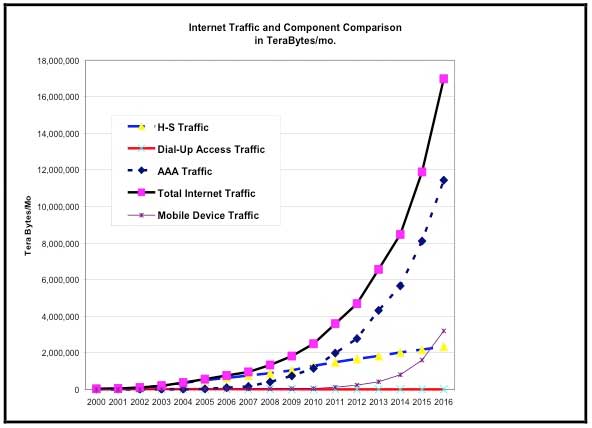 On the graph, H-S = High-speed Access Lines (xDSL and Cable Modems)And we find the scale confusing, but people do have a feeling for what a terabyte is - many have 1 TB hard drives for their PCs. However, a million terabytes is an exabyte - here is the sequence of nomenclature for large numbers: We'll soon be talking zettabytes! Power/Name/SymbolMore information. Facebook Opens New Energy Efficient Data Center, Tells How To Design One Like It Facebook's new data center in Prineville, Oregon, covers 147,000 square feet and is one of the most energy-efficient data centers ever built. They changed the way power supplies work to take advantage of the way electrical power is provided. The building is carefully positioned so that, during both winter and summer, prevailing winds deliver air to the intake vent seen here along the building’s side.  While Web firms such as Google and Microsoft invest a lot in improving data-center efficiency, they keep their designs a closely guarded secret, Facebook is giving away its blueprint so to encourage open collaboration and thus make the Internet more energy-efficient. " We started a project at Facebook a little over a year ago with a pretty big goal: to build one of the most efficient computing infrastructures at the lowest possible cost. We decided to honor our hacker roots and challenge convention by custom designing and building our software, servers and data centers from the ground up. The result is a data center full of vanity free servers which is 38% more efficient and 24% less expensive to build and run than other state-of-the-art data centers. But we didn't want to keep it all for ourselves. Instead, we decided to collaborate with the entire industry and create the Open Compute Project, to share these technologies as they evolve." No word on the issue of fiber vs. copper, but we'll try to track that down. Read More The World's Biggest Data Centers Facebook has the most efficient data center, but not the largest, and that one illustrates the need for energy efficiency. The Lakeside Technology Center in Chicago is a 1.1 million square foot multi-tenant data center owned by Digital Realty Trust. Originally developed by the R.R. Donnelley Co. to house the printing presses for the Yellow Book and Sears Catalog, the building was converted to telecom use in 1999, housing 70 tenants. The building infrastructure includes four fiber vaults and three electric power feeds, which provide the building with more than 100 megawatts of power. The facility is currently the second-largest power customer for Commonwealth Edison, trailing only Chicago’s O’Hare Airport. Grid power is supported by more than 50 generators throughout the building, which are fueled by multiple 30,000 gallon tanks of diesel fuel. Phoenix-based i/o Data Centers has created the world's largest modular data center(830,000 sq ft called i/o New Jersey in a printing plant formerly owned by the New York Times. The facility has its own electrical substation, with 30 megawatts of dedicated power, expandable up to 100 megawatts. i/o Data Centers says it already has enterprise clients lined up, and that its brand new Edison, NJ facility is available for everything from colocation to private clouds. Both these are dwarfed by one in Tokyo at 1.4 million sq ft. Want to know more about the largest data centers? Read this. Fiber + Power = Cell Phone Tower Over the last few months, we've covered the way fiber is more important for cellular wireless, connecting towers and even up the tower to the antenna. One problem, especially in urban areas is the resistance of local residents and governments to the proliferation of cell phone towers. When antennas are so big, they become hard to site unobtrusively and large structures can interfere with reception. Several vendors, led by Alcatel-Lucent's lightRadio (shown), have introduced new miniature cellular antennas, small enough to mount on a traffic signal, street light or utility pole. A product of Bell Labs research (what a nice thing to hear - since divestiture 27 years ago, Bell Labs has been mostly in the background), lightRadio involves changes in the way cellular networks are designed and deployed, but should increase network capacity and make networks both more reliable and less obtrusive. Field trails start later in 2011. 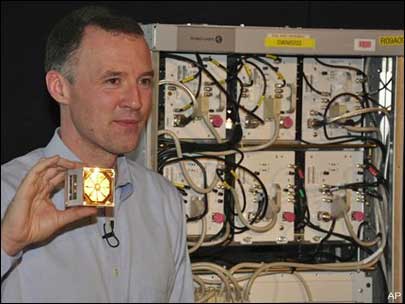 Nokia, Samsung and Ericsson are all working on similar wireless solutions. Another new product, from BelAir, shows a different idea, hanging cellular antennas off aerial cables. 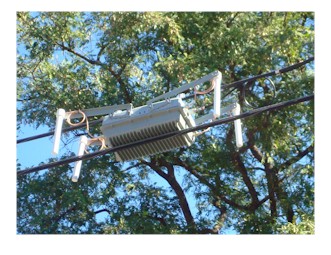 Events of Interest FOA To Present Seminars in Africa in May Come meet the FOA in Johannesburg, Nairobi and Lusaka and learn what's new in fiber! Details Above. 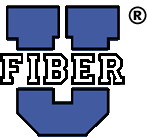 @ @  Fiber U Returns @ OSP EXPO, September 13-14, 2011 Some of you may remember the famous "Fiber U" training conferences of the 1990s where dozens of vendors and hundreds of students converged for a week-long training conference. Now Fiber U is part of the FOA. This year we've been invited to work with OSP Magazine to present seminars at their annual conference. We'll have sessions on Fiber Optics in SmartGrid, Wireless and Gigabit FTTH. AFL to Host "Traveling" Advanced Splicing Seminars AFL has launched advanced splicing seminars intended for industry engineers and professionals, as well as university students, engaged in fiber optic activities involving splicing and for those interested in learning more about fusion splicing technology and methods. The seminars, which will take place around the US, will include
Seattle May 10 There is no charge for attending; however AFL will be conducting pre-registration in order to ensure availability of a proper facility depending upon the number of attendees. Sign up today: http://www.stateofthearc.com/seminars/signup.html Free Corning "See the Light" Seminars Corning is offering free 3 hour seminars on "Termination Technology" in over a dozen cities around the US in the coming months. The seminars focus on new termination techniques and will give attendees real hands-on training. You must pre-register for the seminars, and we recommend you do so soon as they will probably fill up quickly! May 18 St. Louis, MORegister at http://registration.corning.com/1STL%2D2011/  What's New @ FOA What's New @ FOA
 Two New Free Fiber U Self-Study Programs on Outside Plant Fiber Optics and OTDRs There are two new free online self-study programs on Fiber U. "Outside Plant Fiber Optics" uses the new FOA textbook and online reference guide to OSP to help you learn about OSP fiber networks. The "Understanding OTDRs" self-study program will help you learn how to properly use these complicated instruments and there is a free OTDR simulator you can download to use for practice. FOA Certification On Outside Plant Fiber Optics The new FOA CFospT outside plant certification focuses on OSP fiber optic network design, installation and maintentance. A CFospT certified tech must know the ways that fiber is used in the OSP, how it is installed, tested and maintained. While a CFOT might only have a basic knowlede of fusion splicing and OTDR testing, for example, a CFospT will be knowledgeable and skillful in those areas - and more. Reference materials for the new CFospT are the printed textbook, the FOA Reference Guide to Outside Plant Fiber Optics (right) as well as eBooks from Amazon for the Kindle or Apple for the iPad/iPod/iPhone and the OSP reference section of the FOA Online Reference Guide which now includes a self-study guide to the CFospT exam. More information on the FOA Outside Plant Fiber Optic Technician (CFospT) certification. Want to know more about OSP? There's OSP Magazine for that - and a trade show, OSPExpo, running this fall in Cincinnati.
   We have created three new FOA books to be used in training for FOA certifications and as reference books for contractors, installers and end users of fiber optics. These books have full curriculum support, including free curriculum materials for teaching FOA certification courses. Because we are self-publishing these books using more modern "publish on demand" technology, they are easier to keep up to date, easier to buy and much, MUCH cheaper! All are now available in print and electronically in Kindle and Apple iBook versions. Details on the new book each of the new books are at the book pages linked to the photos above. 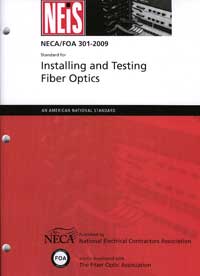 Standards cover components and systems and how to test them, but rarely get into installation issues. The FOA NECA 301 standard which covers installation of optical fiber systems has been revised for the second time, adding considerable new materials. This standard is derived from FOA educational material put in standards form and approved by ANSI as an American National Standard. It's specifically written to be used in contracts to define "installation in a neat and workmanlike manner." The standard is available from NECA. Lecture 4: Fiber Optic Cables 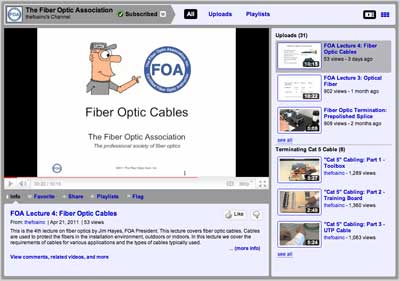 The fourth lecture in our series on fiber optics is now online. It covers fiber optic cables: cable types and applications. View the FOA YouTube video Lecture 4 - Optical Fiber. The FOA is dedicated to make technical material readily available to all those interested in fiber optics. For all 15 years of our existence, we've created reference materials in the form of printed textbooks and web pages. Now our Online Reference Guide has grown so large it needs it's own Google Search and we offer all three of our new books on the Amazon Kindle or Apple iPad/iPhone/iPod. Recently we started our own channel on YouTube and the response has been enthusiastic. So we've been adding more videos to YouTube, including a demonstration of how to use your cell phone camera to detect IR light in fiber systems and have started a lecture series on fiber optics. The first lecture is called "Fiber Optics and Communications" and FOA President Jim Hayes describes the many different uses of fiber in telecommunications, CATV, security, utility and many other networks. Lecture #2 is about Safety in handling and installing fiber. Future lectures will cover the basics of fiber and cable, termination and splicing, installation and testing. Watch for more. FOA Online Fiber Optic Reference Guide New Web Page on Bend Insensitive Fiber Bend-insensitive fiber is a "hot topic" now - we try to explain how it works and what it means for installation and test. Basic Fiber Design Section Updated Lots of new materials added to this introduction to fiber optic network design. New Web Page on Data Centers Data centers are the heart of the Internet, storing and supplying data for user requests. Needless to say, high performance cabling is needed to move the data between storage, servers and routers. We've created a new pagein our Online Reference Guide on data centers - how fiber and cabling are vital to their performance. Learn More About OTDRs - Download a Free OTDR Simulator More and more installers are being asked for OTDR testing but using these instruments is not easy. They are hard to set up properly and complicated to interpret the traces. Using the autotest function can lead to disastrous results! The FOA has a good tutorial on OTDRs on our Online Reference Guide and we added a free download of an OTDR simulator to the OTDR section so you can learn how to use an OTDR on your PC. New OSP Reference Section on the FOA Online Reference Guide website Joining our basic fiber optics and premises cabling sections on the FOA Reference Guide website is a new outside plant reference section that covers materials like that in our new textbook. The material is ready for use and will be followed shortly by a self-study guide. Both the OSP textbook and website are references for the new FOA CFospT outside plant technician certification. More New Info: Links to manufacturers and distributors of fiber optic lighting products. The FOA Online Fiber Optic Reference Guide has become very popular - perhaps the most popular technical website ever, typically with over 270,000 users downloading about 1.6 million pages in 2010! We continue updating materials regularly, keeping it as up to date as possible. Find What You Want Using "Google Custom Search  There's
so much information on the FOA Tech
Topics and Online Fiber Optic Reference Guide
that even a well-organized Table of Contents isn't enough and when the
material is always changing, an index is impossible to maintain. So the
FOA is using the latest technology in search, Google Custom Search,
which will allow you to search just the
FOA Tech
Topics and Online Fiber Optic Reference Guide for
any topic you want to find more about. Try
it! There's
so much information on the FOA Tech
Topics and Online Fiber Optic Reference Guide
that even a well-organized Table of Contents isn't enough and when the
material is always changing, an index is impossible to maintain. So the
FOA is using the latest technology in search, Google Custom Search,
which will allow you to search just the
FOA Tech
Topics and Online Fiber Optic Reference Guide for
any topic you want to find more about. Try
it! Go to The FOA Online Fiber Optic Reference Guide. School News How Well Do Students Get Trained at FOA Certification Classes? Bill Graham of Mississauga Training in Canada sent us a photo of one of his classes' results in terminating 3M Hot Melt adhesive polish connectors. Their results for their tested connectors (dB loss) speak for themselves. 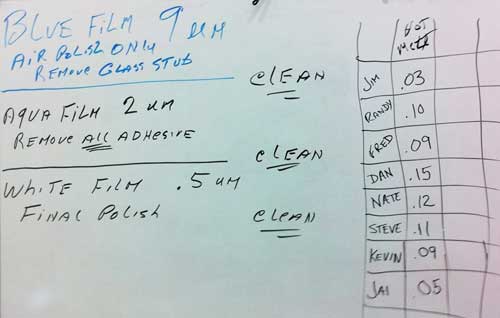 New Schools The FOA welcomes the newest additions to our listing of FOA-Approved Training Organizations: Weber State University, Utah #289 Want to Own The Best School in Canada? Mississauga Training Consultants is looking for a new owner. This 15 year old company is a great opportunity for someone who has fiber experience and likes to teach. Also a great way for a current school to establish a presence in Canada. William will work with the new owner for up to six months to help them get established and grow. If there is not a new owner by April I will consider breaking the company up and selling it in pieces. The web site www.fiberoptictraining.com has top rating. William Graham, CFOS/S/T/C/D/, CFOI Mississauga Training Consultants email: mr.bill.graham@sympatico.ca www.fiberoptictraining.com Tel: 905-785-8012 Cell: 416-659-8713 Find a listing of all the FOA-Approved schools here. It's Now A Lot Easier To Find A FOA-Approved Training Organization 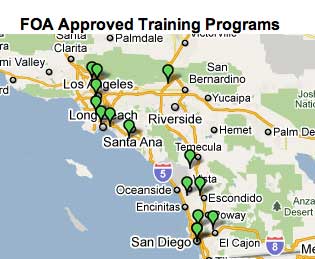 Most phone calls we get regarding finding a FOA-Approved training organization want to know two things: what school is closest to me or what school offers the certifications I need. That can be difficult, since the FOA has almost 200 training organizations we have approved worldwide! We've been looking at ways to make it easier, and we think we've got a good solution. In fact we have two solutions. First we have added a sortable table of all the FOA-Approved schools. You can also use our FOA Google Map Application to find FOA-Approved schools. Here are links to the sortable table of all the FOA-Approved schools and FOA Google Map. What Should A Fiber Optics or Cabling Tech Know and What Skills Do They Need? The FOA has been updating its lists of KSAs (Knowledge, Skills, Abilities) for fiber and cabling techs. The updated list is now on the website for your information and comments - as fiber and cabling KSAs evolve as new technologies develop. KSAs for fiber and cabling techs. Good Question! Tech Questions Worth Repeating Tech Hint: Did You Know You Have A Fiber Optic Tester In Your Pocket? Yes! The camera in your cell phone is sensitive to infrared light - lots more than your eye - and can detect light in an optical fiber or from a transmitter. Chris Hillyer,CFOT/CFOS/I, Master Instructor, Northern California Sound & Communication JATC sent us some photos showing how this works. See below or the video now on YouTube. Changing From 62.5 to 50 micron MM Fiber Q: Right now we use 62.5 micron to connect our legacy system (desktop). Do we need to upgrade our hardware if we move to 50 micron ? A: There are several answers to this question, which we will address separately not so much providing answers as outlining issues that need addressing. 1. Interconnecting 62.5 and 50 micron core fiber, as in patch panels: This is generally not a good idea. The difference in core size and numerical aperture (the angles of light accepted by the fiber) between 62.5 and 50 micron fiber causes the amount of light loss in connections between two fibers to be highly directional. Depending on the types of transmitter sources, the excess loss causes by the mismatched fibers can be as large as 1.6 dB (http://www.thefoa.org/tech/fib62-50.htm) when going from the larger 62.5 micron core fiber to 50. The loss in the other direction (50>62.5) may be slightly less than connecting equal size fibers due to the lesser sensitivity of the fiber connection to geometric offsets, but not enough to offset the loss of the opposite connection. Many systems have enough loss margin to easily accommodate this much excess loss if the links are short and losses are well under the maximum allowed loss budget (http://www.thefoa.org/tech/lossbudg.htm) 2. Coupled power from sources may be lower: Due to the smaller core size and numerical aperture (the angles of light accepted by the fiber) of 50 micron fiber, the amount of light coupled from the transmitter of the equipment may be lower. LED sources have a larger difference as their light patterns are more unfocused, often overfilling all multimode fibers. 850 nm LEDs and surface emitting 1300 nm LEDs have greater differences than 1300 nm edge-emitting LEDs which were used in some FDDI and ESCON systems in the 90s. VCSEL sources used in most systems at 1 Gb/s - and many current 850 nm data links - will have much less difference because the light from a VCSEL is more tightly focused into the center of the MM fiber core. Regular 1310 nm SM lasers used in some data systems will effectively see no difference. This is something easily tested. You need a 62.5 micron patchcord, a 50 micron patchcord and a power meter. Test the coupled power from a transmitter with the power meter using each patchcord and note the results. The difference in coupled power needs to be subtracted from the loss budget when using 50 micron fiber. The narrower beam from the 50 micron fiber may make coupling to receivers more efficient, but that's a tricky one to test. Some equipment manufacturers will provide loss budgets for both fibers, so you can avoid the testing. In the last decade, most fiber optic communications systems will work equally well with either fiber type. Particularly premises systems, like your desktop connections, generally have plenty of margin with either fiber type. Some systems like CCTV cameras my have links long enough to cause concern. But the simple tests above, or a review of equipment documentation, will settle the issue. You can find much more information on the FOA website, particularly our online reference guide (http://www.thefoa.org/tech/ref/contents.html) and we have a special site for users of fiber optic systems that may be helpful ( http://www.thefoa.org/user/index.html print version http://www.thefoa.org/tech/guides/UG3.pdf). Testing Splitters and Couplers Q:How do I test a 70/30 splitter? A: Use the power meter and light source to test the splitter. If it has connectors, you can test it just like two patchcords. Attach a patchcord to your source and measure the output power. It helps to measure in mW or microwatts, but can be done either way. Let's say the test source/patchcord output is 1 mW (-30 dBm) Connect the splitter input (the side with one fiber) to the test patchcord. Measure the power out of the two splitter outputs. [S]-----patchcord]---------------ConnC--------------[Splitter]-----------------Conn[Power meter] If it were a perfect 30/70 coupler, one leg would be 70% of the 1 mW input or 0.7 mW (-1.55 dBm) and the other would be 30% of the power or 0.3 mW (-5.23 dBm). Both those dB changes are the same for any input: -1.55 dB for 70%, -5.23 dB for the 30% output. Here is an Excel spreadsheet that calculates dB/power ratio and dBm/milliwatts Since no coupler is perfect, the power you measure will be lower - and includes the connection from the test patchcord to the coupler. So if you measure the 70% leg and it has -2 dB instead of -1.55 dB, the excess loss including the input connector is 0.45 dB. If you have specifications for the coupler, they should give a spec for excess loss. You should look for how closely the outputs are at the 70/30 ratios and how much excess loss each output has. The specify testing the link without the connectors on the ends while most standards say include them. Why? A: We can make an educated guess - well two. First, in order to test a pigtail transmitter's output power, (and pigtail sources are typical of most laser transmitters), you generally attach a pigtail and test it with a power meter, so the output power includes that connector loss. When you measure power, the meter has a detector that looks directly at the end of the fiber in the connector, so there is no connector loss. Thus, the way power is measured at both ends of the link corresponds to the way the "main optical path" is defined in this diagram. Secondly, if you are testing the link with an OTDR, most operators generally will not measure the connectors on either end. We've heard from many telco types that they only test with OTDRs and this is how they make the measurements. See also the question " more on loss budgets" below. Q: We are required to do PMD testing on a long distance cable plant. What do I need to know? We did some study on PMD for the web page on testing CD/PMD/SA: http://www.thefoa.org/tech/ref/testing/test/CD_PMD.html That page gives a rundown on PMD and the tests currently approved - 5 in all. Exfo offers several versions of testers, JDSU has field equipment also. See http://www.jdsu.com/en-us/test-and-measurement/products/a-z-product-list/Pages/pdm.aspx or more generally http://www.jdsu.com/en-us/Test-and-Measurement/Products/field-network-test/fiber/dispersion-cd-pmd-ap/Pages/default.aspx where you can download the JDSU book on testing, Volume 2, that covers PMD. There are a number of Exfo tech papers. Just google "Exfo PMD testing" I think Anritsu and Agilent may make equipment for PMD testing. Summary of what we have learned. 1. PMD testing is quite imprecise because it is a changing parameter. I have a paper showing how it changes in the wind on aerial cable! 2. The different methods produce similar but not quite the same results. See 1. 3. What people seem to look for is "boundaries" - an envelope around the measurements giving the worst case. Standard For Installation? Q: Is there a standard for testing and certification of installation in an industrial environment? A: The FOA has worked with NECA to create ANSI/NECA/FOA 301, an installation standard for this purpose. It's intended use is to be used as a document defining proper installation for contracts. I can send you a copy if you like. You might also find these pages on our reference website useful: Section for users of networks: http://www.thefoa.org/user/index.html PDF to print: http://www.thefoa.org/tech/guides/UG3.pdf Section on project paperwork: http://www.thefoa.org/tech/ref/install/paperwork.html Designing fiber optic networks:http://www.thefoa.org/tech/guides/DesG.pdf Termination Times Q: Has your group ever done a study or analysis on how long it takes to complete assorted field terminations? I’m looking for average values as there can be so much variation due to skill level, equipment availability, experience, etc. A: Around 1997, several of the Fiber U instructors did a comprehensive time and motion study on termination. They compared several types of termination processes under several different scenarios, since sometimes you only do one or two connectors at a location and sometimes a dozen or more Times were based not just on termination times, which are in the data tables, but also setup, cable prep and cleanup times to make the analysis representative of real world installations. And while the instructors involved then were very skeptical of prepolished splice connectors then, they have become much better! (see above) However, I think the times are still representative. And the cost data can be updated to represent current prices for the connectors. Read the article on termination times. Mix and Match Connectors Q: With SM fiber, can one end have SC/APC to the equiment and SC at the patch panel? Patch panel is in place and equipment needs APC. A: Use a SM patchcord with one end SC/APC and one end SC. Just specify a higher grade of PC polish (UPC is what some vendors call it) to reduce reflectance. Don't try to mate a SC to a SC/APC - it may damage the connectors. That's Why They Call Them "Dust Caps" Q: We clean a connector, inspect it to ensure it is clean then put the dust cap on. If we inspect it after we remove that dust cap, it's dusty again, we assume from dust in the cap. I have tested different types and makes of dustcaps for the LC and clean ones are rare. If you only push them on half way it helps.....sometimes, but not always. Does any company make clean (guaranteed) ones? A: I've been saying for years that the reason they call them "dust caps" is they contain lots of dust. I know of no clean ones. Think about how they are made in millions and dumped in big bins in a factory! You just have to clean connectors when you remove them. Have you tried some of the dry cleaners? They seem to work well. Midspan Entry Q: How difficult or easy is it to fusion splice one buffer tube and leave rest of the buffer tubes uncut in a fiber optic cable? This is in regards to carefully cutting only one tube, while not damaging the fibers in the other tubes of the fiber optic cable. A: You can get a special tool for this process which is called "midspan entry." Check with the cable manufacturer. Here is a link to a special Draka tool. More on Loss Budgets Q: Reading your tech article labeled lossbudg.htm, I think there are some redundant losses calculated. You show a setup with a TX connected through other connectors (patch panel) a splice another patch panel and connected to a receiver. You state that you consider all of the connectors to have loss, including the connectors at each end. I question this concept. When a fiber optic transmitter states the output power parameter, say -20dBm launched into 62.5/125 fiber optic cable, it already takes the connection to the transmitter into consideration. The fiber, once connected to the transmitter should be receiving -20dBm of light power. The same situation exist at the receive end. The receiver states that it has a maximum sensitivity of -32dBm, from a 62.5/125 fiber optic cable. The only way to measure this is to connect a fiber optic cable to the receiver and vary the power to determine the lowest level at which the receiver will operate then measure the light out of the fiber cable. This connector is part of the measurement and should not be used as part of the power budget calculation. I submit that the only elements to be considered in calculating power loss are the patch panel(s), splices, and fiber cable attenuation. If a TX states minimum power launch is -20dBm and the receiver states maximum sensitivity is -32dBm then this pair of equipment has an optical budget of 12dB. One should expect that when they connect the patch cable to the TX it will launch -20dBm and when they connect the patch cable to the RX it will launch all of the light exiting the fiber optic cable onto the RX. The only elements that can cause attenuation are those elements between the TX and RX connectors. A: The concept of the loss budget has two viewpoints: 1) The systems people need to know how much cable plant loss their transmitters and receivers can tolerate and 2)The fiber designers/installers need to know if their cable plant will support the communications system that is supposed to use the cable plant they install. Both need to know that the connections at the equipment couple the proper amount of light into the fiber from the transmitter source and transmit the proper amount to the receiver detector as well as the intermediate losses are within reason. The coupling at either end will only happen if the connectors on the ends of the cable are low loss. The cable plant designers and installers generally do not have the equipment onsite to use to test connectors for proper coupling to transceivers, but they do have the test equipment to test the connectors against another known good reference connector. Systems people who test their equipment for coupled power, however, do have the ability to test their products with known good connectors, so their coupled power numbers assume a certain performance level, e.g. low insertion loss, from the connectors used for the coupling. This line of logic has led us to have a convention of including the connections on the end of the cable plant in the loss budget. In the early days of fiber optic standards, there were some strays! IBM once used a 3-cable reference for their systems because they came to the same conclusion that you did and the 3-cable reference reduced the measured loss by two connector losses, making them think they had made the proper compensation. But the logic proved wrong (see http://www.thefoa.org/tech/ref/testing/5ways/lossmath.html) and they realized the 3-cable reference had a higher measurement uncertainty (see http://www.thefoa.org/tech/ref/testing/5ways/fiveways.html toward the end). Now by convention, when the systems people specify a power budget, they generally use the testing standards which include the connectors at the end, and I believe this is true for all standardized networks. So the method we specify works for both systems and cable plant analysis and is the accepted version. Have you ever tried to test coupled power with known bad or dirty connectors? It's an interesting experiment! And some transceiver's couplings are very different with 62.5/125 and 50/125 fiber. There are also test standards for coupled power and they specify using cables with tested connectors of low loss. Fiber Backhaul Instead of Microwave for Wireless Q: I am in a small remote alpine town creating a case to have fiber optic backhaul instead of the beleaguered microwave link currently provided by the iLEC. Could you please point me in the direction of any materials that would empirically support the advantages of fiber backhaul for remote sites vs the dis-advantages of microwave links. The microwave system we're trying to get the iLEC to replace spans about 35miles per hop, and "supports" three DS3 equivalent circuits; but real world performance is pretty poor from the end user's perspective. Since the town is fed with DSLAMs, it's tough to really load the link until all the tourists are here making cell calls, using mobile data, and occupying the residences & hotels -then the link really maxes out. If we have a busy weekend, and get 48" of snow over night - same thing - delay, jitter, congestions of the available path. A: Microwave has been used in many areas where fiber is hard to install, like mountains, but with the advent of 4G systems carrying lots of data and video, microwave is giving way to fiber backhaul. In fact, one of the biggest areas for fiber expansion today - plus they are using it to connect the antennas on the tower. Try this: http://connectedplanetonline.com/images/CP_ADC2_WhitePaper.pdf Fiber Cleaning This is a topic we keep reminding everybody about, and here is why: From a contrator in the Middle East: Here some samples of the connectors for SM fiber already installed in the system we were testing. 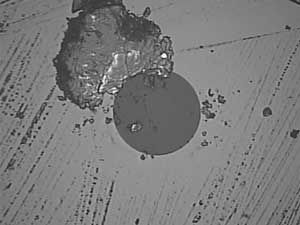 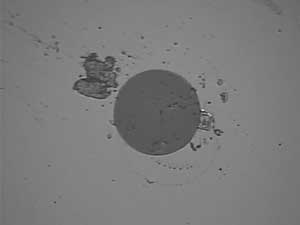 As you can see, the dirt is large compared to the size of the fiber (dark gray), and the core (not visible here) is only 9/125 of the overall diameter of the fiber! More on cleaning. See Product News below for links to vendors of fiber cleaning products. Measurement Uncertainty: Everyone testing fiber optics should understand that every measurement has some uncertainty - whether you are measuring loss, length, wavelength, power, etc. Knowing that uncertainty is very important to interpreting the measurement. It's worthwhile to read and understand the issue of measurement accuracy covered in this page of the FOA Online Fiber Optic Reference Guide. Worth Reading: Searchable IGI Publication Archives Now Available as Google eBooks Information Gatekeepers Inc. (IGI), a leading international supplier of information on fiber optics and telecommunications markets and technology, has entered into an arrangement with Google to make its archives available as Google eBook. Since 1977, IGI has been publishing newsletters, conference proceedings, market research reports, and other publications focused on worldwide markets in telecommunications and fiber optics. With Google eBooks , all of these publications and studies — including previously unavailable earlier works — are now available in searchable, electronic format to market researchers, financial analysts, lawyers, governments, university researchers, libraries, and all other interested parties. Please search our new archive by visiting igigroup.com or entering search terms in the box below. The new Google eBooks of IGI publications are also the best available for reading on mobile devices. Google eBooks can be read on the Web, Android phones, iPhone, iPad, iPod touch, and supported eReaders. Learn more about our supported devices. For more information on the new Google eBooks of IGI publications please visit igigroup.com. You can search Google Books for IGI publications directly - Go here. Ensuring Distance Accuracy On OTDR Measurements By JDSU. The Victorian Internet by Tom Standage 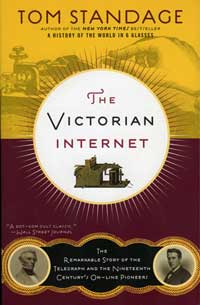 If you think the Internet has changed communications in recent years, consider the effects of the introduction of telegraphy 150 years ago. Communications went from as slow as horses, ships or trains could carry news to instantaneous! Who was the first to use it? Stock traders, of course, and low latency is still their goal! It's a good read, and you'll find out some new info on Thomas Edison! On Amazon. Broadband Properties Webinar Archives  Lots of interesting webinars, mostly on FTTH. Go here. FTTX Networks An ADC white paper on how they work and how networks are upgraded to FTTH. http://connectedplanetonline.com/images/CP-ADC3-WhitePaper-v4.pdf. JDSU Application Note On "Qualifying FTTH Network before Equipment Installation" Another great paper from JDSU covering FTTH PON networks is available for downloading. It gives an overview of FTTH architecture, cleaning connectors then testing the cable plant with OTDRs and OLTSs. This paper will help you understand why OTDRs can be confusing on PONs! Best Practices For Wireless Backhaul Network Upgrades Joan Engebretson, Contributing Editor of Connected Planet has written a very good overview of how fiber is essential to the operation of cellular wireless systems. Everybody probably knows that fiber is used to connect towers into the telecom network - they call it backhaul - but her article also covers the new appliations to replace bulky, heavy, lossy coax up the tower to the antennas. http://connectedplanetonline.com/images/CP_ADC2_WhitePaper.pdf. Fiber Optic Safety Poster We've had numerous requests to reprint our guidelines on safety when working with fiber optics, so we have created a "Safety Poster" for you to print and post in your classroom, worksite, etc. We suggest giving a copy to every student and installer. Corning now offers videos on  .
Lots of interesting videos, some technical, some sales, but all good
information. .
Lots of interesting videos, some technical, some sales, but all good
information.US Conec's videos on cleaning fibers - show's the results of proper cleaning. Webinars of Interest Broadcast Engineering Magazine - Fiber Optic Testing FOA President Jim Hayes presents an overview of fiber optic testing for all applications. Available on Demand. Sign up here. Multimode Fiber Trends from TIA's Fiber Optics LAN Section Ryan Chappell, Draka Communications, looks at the evolution of multimode fiber, examines its current usage and shares predictionson its future Available on-demand at: http://www.brighttalk.com/webcast/7182/play OSP Magazine Webinars OSP Magazine (OSP as in outside plant telco) is now offering a number of interesting webinars that cover fiber topics, including network design and specialized components. http://www.ospmag.com/events/web/ Multimode Fiber Characterization Launch Condition Considerations - new ap note from JDSU JDSU Reference Guide to Fiber Optic Testing – Volume 2 Published  The second volume of the JDSU series on fiber optic testing has been published. Volume 1 focused on Basic Fiber testing and Volume 2 is geared toward fiber optic installers, project managers, telecom technicians and engineers who need to understand fiber networks. Volume 2 also covers Chromatic Dispersion, Polarization Mode Dispersion, Attenuation Profile and Fiber Link and Network Characterization. A 3rd volume, a glossary of fiber optic terms, is also available for download. This is a "MUST HAVE" for all fiber optic techs. Download your free copies here. We used this book as one of our references in creating a new page in the FOA Online Reference Guide on chromatic dispersion (CD) and polarization-mode dispersion (PMD). Careers in Fiber Optics: Brian Smith. A 1998 book on fiber optic jobs is a bit dated, but a free overview is on Google Books and worth a look at it online. Dirt! As much as 70% of the problems associated with deploying fiber to the home result from something as simple as dirty connectors according to JDSU. Telephony Online. US Conec's videos on cleaning fibers - show's the results of proper cleaning. Good Technical Websites American Polywater (http://www.polywater.com/) has one of the best technical website for cable installers. Here is a rundown on some new material on their site. Cable Installation using "Push" or "Push/Pull" Polywater's new Pull-Planner™ 3000 Software allows a "pushing force" variable in pulling tension calculations. Read a White Paper that quantifies the push contribution and compares calculation results to field experience. -- http://www.polywater.com/pushing.pdf Pulling Cable Through Water? Read a Product Spotlight on Polywater® + Silicone™, Polywater's new generation underground lubricant. Continued reduction of friction when pulling through water is only one of the unique features of this lubricant. -- http://www.polywater.com/NNNBSL.pdf Check out their website, especially “Videos,” “Engineer’s Corner” and “Calculators.” http://www.polywater.com/NNNBSL.pdf  " Heard on the Street" is a monthly online newsletter from Frank Bisbee of Communications Planning Corporation that covers the telecommunications and cabling businesses. Each month includes news from manufacturers, trade associations and professional societies like the FOA. You can read the current issue and back issues online.  JDSU has announced the See the Light webinar series, a four-part program designed for anyone involved in the installation, maintenance, and repair of fiber optic systems. It begins with fiber inspection and cleaning and then covers the basics of fiber testing. The webinar series then continues with the more advanced optical time-domain reflectometer (OTDR) and fiber local area network (LAN) testing challenges. More information on the series. IGI is offering a series of webinars on topics of interest to those in the communications industry. You can join them live ir download from the archives. IGI WEBINAR ARCHIVES UP AND RUNNING - VISIT TELECOMBRIEFINGS.COM TO DOWNLOAD! IGI, a major market research and technology reporting company (the "Active Optical Cables" below) is offering a a free one year subscription to one of our fiber optics newsletters to FOA members. All they have to do is to send IGI an e-mail stating which newsletter they would like to get. See http://www.igigroup.com/nl.html for a listing of IGI Newsletters. A Fiber Optic Tester In Your Pocket? (See the video on Yes! The camera in your cell phone is sensitive to infrared light - lots more than your eye - and can detect light in an optical fiber or from a transmitter. Chris Hillyer,CFOT/CFOS/I, Master Instructor, Northern California Sound & Communication JATC sent us some photos showing how this works and the following description. 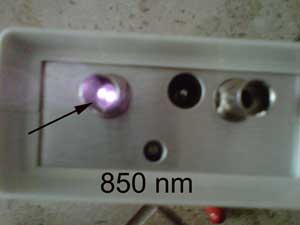 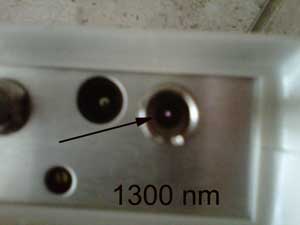 "Your cell phone camera's image sensor can read IR light. It uses this technology to help take pictures at night. In the advanced audio and CCTV field they have been using the smart phone camera to trouble shoot problems in IR communications. The human eye cannot see the IR light emitted by let’s say a remote control. Well up until now we would always say that the remote is out of batteries, or either the IR transmitter or IR receiver was not working properly. Now we can use your smart phone camera to see the IR light emitted by the IR transmitter. All you have to do is turn on your camera function on your smart phone and hold it up the remote control and push any button. The cameras screen will show the IR light. Now back to Fiber Optics. If you follow the same principals of the last paragraph, let’s say you wanted to check if a fiber port was energized. You can either use the card that is supposed to show you in a few seconds that the port was hot. Or you could plug in your meter, in this case it takes some time to find the card or if you don’t have your meter handy. Just pull out your smart phone turn on the camera and hold it over the port. If it is hot you will see a bluish white dot in the fiber bulk head (see attached pictures)." We tried this ourselves and found our camera phone very sensitive at 850 nm but as expected less so at 1300 nm, like all semiconductor detectors. Our phone could still see 1300 nm sources at around -20 dBm, making it very useful even for LED sources, and of course, perfect for lasers. OFSTP-14 Update OFSTP-14 is the TIA standard for testing installed multimode fiber optic cable plants which has been around more than 20 years and is the one TIA standard probably most familiar to contractors and installers. The TIA has adopted IEC 61280-4-1 as the replacement of OFSTP-14. Most of the two documents is the same, with some important exceptions.
We are creating a web page to explain the differences and will give you a link shortly. In the meantime, continue testing as usual.
POE and Fiber? Just use a new AFL composite cable AFL introduces a new composite cable that combines flexible stranded copper conductors with communication links utilizing fiber optic technologies. Ideal for security networks, IP enabled appliances and wireless access points. 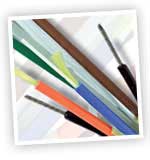 http://www.afltele.com/news_events/eNewsletter/2011/02/AFL_Copper_Fiber_Composite_Cable.pdf Surplus Fiber Optic Cable 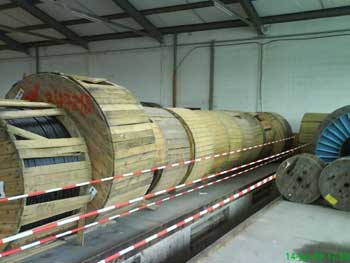 Lucent 216 fiber ribbon cable, Truewave fiber, armored and suitable for direct burial or pulling in ducts. 1416 km of the cable for sale. Manufactured in 2001, stored in warehouse, recently tested. Contact Klaus Prestele <Klaus-Prestele@cooperation-exchange.com> Tiny Fusion Splicer Would Fit In Your Pocket 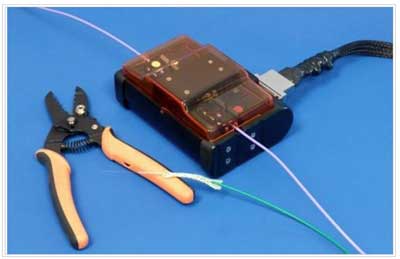 Aurora Optics has created a fully automatic fusion splicer, called the MiniMod, that is made in 2 parts and the splice head is only the size of a digital camera. Aurora says the splicer's size makes it usable in extremely difficult and hard-to-reach environments. The MiniMod is operated from a remote control unit, connected by an umbilical cable. This setup enables the splicer to offload functiions that do not have to be at the fiber location, such as display monitor, control keypad, microprocessor and power supply. Only those functions directly affecting the fiber (imaging system, precision fiber positioners and high-voltage fusion arc) are kept in the splicer itself. 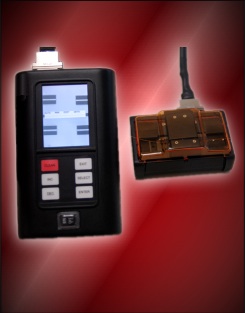 Aurora says that despite its small size, the MiniMod maintains high levels of sophistication. The splicer's features include three-axis auto alignment, automatic fiber placement, sub-pixel image processing, sophisticated arc fusion control and splice-loss estimation. The MiniMod works in any orientation, including upside-down, and meets MIL-PRF-28800 environmental specifications including ambient temperature from -10 to +55 degrees Celsius, relative humidity from 0 to 95 percent and altitude to 5000 meters. Typical loss for a singlemode fiber is 0.02, according to Aurora. Aurora Optics AFL Offers Neat Solution For Prepolished Connectors Prepolished connectors have gotten much better recently as manufacturers move to using quality cleavers for fiber preparation and VFLs to verify a proper splice termination. Corning has incorporated these into their Pretium kits with a VFL and GO/NOGO indicator in the termination tool. Now AFL has another solution. On their FAST connectors, they have a clip that functions as an indicator for the VFL and the crimp tool for the fiber. Watch this video for a better explanation. (Read our "test drive" of the Corning Unicam above.) A Cable Tie That's Fiber Friendly We're always warning installers not to tighten cable ties too tightly around fiber optic cable (or UTP copper cable either!) A better choice is the hook and loop fastener ties (Velcro is one trade name), but there is another type, the Mille-Tie. It's an open tie that can be used at any length, then cut off and the remainder used also. Take a look a the video to see how it works. Mille-Tie Video: http://www.youtube.com/watch?v=QPVTQGKmcvE The FOA has created a new Reference Guide page on bend-insensitive fiber. Corning ClearCurve® Bend-Insensitive (BI) Optical Fiber Compatible With Other Multimode Fiber Types See the Corning Web Pages On BI Fiber for more details. Corning ClearCurve® multimode optical fiber combines the high bandwidth performance of laser optimized fiber types, e.g. Corning InfiniCor® SXi (OM2), InfiniCor®SX+ (OM3) and InfiniCor® eSX+ (OM4) fibers, with advanced macrobending performance. ClearCurve® multimode is specifically designed for Enterprise networking applications such as LAN (local area network), SAN (storage area network), campus networks and Data Centres. All Corning ClearCurve multimode fibers are able to support transmission speeds of 10/100 Mb/s through to 10Gb/s and are ready for next generation speeds of up to 16/40/100 Gb/s. • ClearCurve OM2, OM3 and OM4 multimode fibers are compliant and fully backwards compatible with all relevant industry standards;
multimode installed base
• ClearCurve multimode fiber may be spliced or connectorized to conventional 50/125 fiber types with commercially available equipment and established practices and methods; no special tools or procedures are required. Testing has been done with Corning fibers and various competitive standard and bend insensitive fibers and no issues were observed. Corning has stated that all their MM fiber will be BI fiber and has created an app note on how to implement the TIA-spec mandrel wrap with this fiber. Here is the complete information reported in the FOA April Newsletter. Benchtop Connector Cleaner 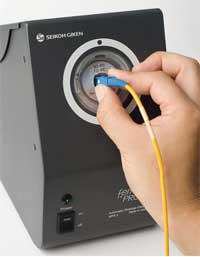 FerrulePro™ is the world’s first fully automated benchtop fiber connector cleaner for laboratory and cable production environments. It automates the final cleaning of all types of terminated fiber products, a critical task where performance once depended largely on the production line worker’s skill. Fiber connectors can be cleaned in 3 seconds cycle - eliminating the need for re-cleaning after post production inspection. More.
They're still being used for high power laser delivery - up to 80-100W! Seikoh Giken has even introduced some new ones. Used Test Equipment – Buy or Sell http://www.testequipmentconnection.com/ Have you read the FOA Tech Topics on Cleaning? More links on cleaning: Cleantex Alco Pads Testing FTTH JDSU shows how to test a PON with an OTDR: http://www.jdsu.com/other-literature/PON-OTDR_fop_an_ae.pdf US FTTH Connections Continue To Grow 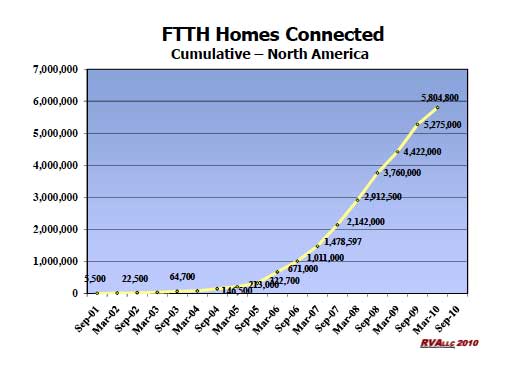 According to a FTTH Council Report prepared by RVA, FTTH connections continue to grow in North America - 99% of which are in the US, but growth seems to be slowing, probably a consequence of the current economy. Much of the FTTH deployment in the US has been due to Verizon's $23 billion investment in FTTH, but the report noted that FTTH is now being deployed by more than 750 service providers across North America. Most of these service providers are small, independent telephone companies that are replacing their copper lines with end-to-end fiber to ensure their future competitiveness as broadband providers. Of the service providers not yet offering FTTH, a majority say they are likely to soon. You can download and read the entire report from the FTTH council website. http://www.ftthcouncil.org/sites/default/files/RVA.FTTH_.Apr10.040712Final.pdf David Chaffee's FTTH Prism Newsletter is Online (archives are at bottom of the linked page)
|
What Is The FOA? Hear FOA President Jim Hayes tell the FOA Story in a 2-part interview by Sound & Video Contractor Contributing Editor Bennett Liles. It tells about the FOA history, goals and achievements. Part 1: http://svconline.com/podcasts/audio/fiber_optic_association_part1/index.html. Part 2 http://svconline.com/podcasts/audio/inside-fiber-optic-association2-0924/index.html. |
|
Digging Safely (Read the FOA Tech Topic) There is a new toll-free "call before you dig" number: 811 See www.call811.com for more information National Fiber Optic Protection Summit: By the "811" group. March, 2008 in Vegas.
|
|
|
New FOA Jobs Website We get many questions from CFOTs, students at FOA-Approved schools and others contemplating getting into the fiber optic business regarding jobs in fiber optics - and how to find them - so we’ve created a new web page to share some information we've gathered about jobs in our industry. The information is designed to help you understand what jobs are available in fiber optics, how to find them and apply for them. While the overall economy is pretty bad - you've probably heard that there are 5 times as many people unemployed in the US as there are jobs available, telecom is a bright spot - broadband is a major focus of stimulus spending in the US and countries around the world are building fiber networks as fast as possible. Even wireless companies have to build fiber for their backhaul. Cities are installing fiber linked surveillance cameras and smart traffic lights. Fiber is the link making Smart Grid possible. Companies like Allied Fiber are building large private networks. Telecom is one of the fastest growing businesses worldwide. If you are looking for a job in fiber optics, here is the FOA's guide to jobs. The FOA has created a group on A list of 10 ways to get your resume noticed from Marketplace on NPR Jobs Created As Part of Stimulus-Funded Projects The federal government is spending 7.2 billion dollars on the Broadband Technology Opportunities Program. This money is working it's way into the economy and hopefully will provide jobs. You can track recovery dollars and look for job opportunities on this website: www.recovery.gov Go to "opportinities" link then "jobs". You will see a section “find recovery jobs” – enter “fiber optic jobs California” or wherever you are and review what comes up. One of the projects funded by stimulus money is the1100 mile network of Maine Fiber Company Inc. which has selected nextGen Telecom Services Group Inc. as the installation contractor. CFOTs: NextGen has a link on their website for applying for jobs Cable Manufacturing and Development Engineer (4/11) Chromis Fiberoptics has an immediate opening for a cable manufacturing and development engineer. The successful applicant will be responsible for overseeing the manufacturing and development of numerous cable products based on plastic optical fibers. Responsibilities include managing the operation, upgrading, and maintenance of cable manufacturing lines, maintaining a related quality control system, and managing a small production workforce. The successful applicant will also be responsible for development of new cable types, including material selection, process engineering, and customer interactions. Experience and education in areas related to precision extrusion processing are a requirement. Experience and training in optical cable manufacturing are highly desirable, but not required. Experience in manufacturing precision custom extrusions, cables, or tubing are also desirable. Basic electrical and machine tool skills are also a requirement. Management experience in a high-tech manufacturing environment is highly desirable, but not required. Bachelors or Masters Degree in Mechanical Engineering, Polymer Engineering, Chemical Engineering, or related field is expected, but other applicants with exceptionally relevant backgrounds will also be considered. Chromis Fiberoptics is located in Warren, NJ. They manufacture a variety of patented polymer optical fiber products for data-center, consumer, and building networking applications. As a small, fast-growing company with a compelling product, they offer an opportunity to work with accomplished, highly motivated colleagues, and an excellent chance for a well-qualified individual to advance and grow with the company. They have a very competitive compensation plan, including medical benefits. Further information is available at www.chromisfiber.com. Email: hr@chromisfiber.com Sales Person / Account Executive. The location is in Plano, TX 75074. We would like someone in this area with at least 3 years experience in Fiber Optics. Duties: Generating and following up on sales leads, writing sales and marketing materials, proposals and quotations. Optical Cabling Systems has been building fiber optic solutions and assemblies for over 14 years. Our goal is to present information to our customers about the industries best practices for connectivity solutions such as ESCON, FICON, SAN, LAN, WAN, MAN, DWDM and general network connectivity in order to find the solution that provides the most value to each end user. Our services range from providing fiber optic patch cords to planning, designing, installing, documenting and warranting a complete turnkey connectivity solution. Contact: Shirley Amrhein Director of Human Resources Optical Cabling Systems 2621 Summit Suite 100 Plano, TX 75074 Fax # 972 331-0144 Tele# Direct 972 999-2829 samrhein@opticalcablingsys.com OSP Fiber Construction Consultants The Michigan Public Health Institute has posted an RFP that seeks OSP fiber construction consultants to assist three hospital systems in their quality assurance (QA) oversight of the construction of hospital-owned fiber optic networks. The consultants may range from sole practitioners to large firms. Copies of this RFP may be obtained three ways. An Adobe Acrobat (PDF) version is available on the USAC Pilot Program “Search Postings” website at: http://www.usac.org/rhc-pilot-program/tools/search-postings-2009.aspx. Go to the list of Michigan RFPs, look for this RFP (designated as RFP #: 04), and click on the Project Scope Detailslink. A PDF version will soon be available on MPHI’s fiber-build project website at: http://fcc.mphi.org/fiber. Click on the RFP 04 Document link. Contractors may also request a Microsoft Word or PDF version by contacting the MPHI project team at fcc@mphi.org. This RFP references its companion, RFP 03, “Outside Plant Fiber Construction for Five Michigan Health Care Providers,” which seeks contractors to build six fiber networks. RFP 03 may be obtained from the USAC website (look for RFP #: 03), from MPHI’s website (click on the RFP 03 link), or from the MPHI project team. An Information Sessions for potential contractors will be held on March 23 in Okemos, MI. Interested parties may attend by dialing the teleconference number. Bid requirements are relatively simple and straightforward. Bids are due April 12. Channels Sales Manager | Telecom | Outside Plant | US | North America Region Global leader in the telecom network equipment space is seeking a Manager for Channels Sales. This position will take a leadership role developing and executing comprehensive sales strategies to maximize opportunities with distribution partners and manufacturer representatives throughout the US, Mexico, & Canada. This role requires a passionate and effective individual who will be responsible for managing a team of regional sales leaders. He/She will create programs, reporting, and forecasts for senior management. This is an exceptional opportunity to make an impact and grow within a great company. Based out of the corporate office in Minneapolis/St.Paul; (remote/virtual office acceptable) -- this position will report to the Americas VP of Sales & Marketing. He/She will have interaction with senior level counterparts in cross-functional groups. Our ideal candidate will have significant sales management experience in telecom Outside Plant and Central Office systems/products. Strong distribution channels, account management sales experience a must. Qualifications · 8+ years sales//business development experience in telecom equipment distribution channels, manufacturing representatives. · Product knowledge of Fiber, Copper, Cabling, Connectors, Network Systems, Connectivity Components, and Related Products, Wireless a strong plus. · Previous experience managing sales representatives in multi-state/multi-market territories. · Superior interpersonal and presentation skills, ability to solve problems and collaborate with cross-functional counterparts. · Comfortable in a fast paced work environment, with multiple concurrent projects and priorities. · Ability to travel (up-to-70%). · Bachelor’s degree in Business/Marketing/Engineering; MBA, strong plus! · Bilingual Skills: English/Spanish, strong plus! Compensation: Attractive salary; comprehensive benefits package. Relocation assistance available. Interested Candidates: Send resume in a word doc to- Justin@thomasseymour.net Tel. +1.404.425.2415 About Us: Based in Atlanta, Thomas+Seymour Group is a boutique firm conducting searches for executive talent both nationwide and overseas. Confidentiality is a very important aspect of our business. As a candidate, when you send us your resume, you have our word that we will not share your information without your prior consent. Business Development Manager OFS – Specialty Photonics Division - 2/2011 From its roots in Bell Laboratories through Lucent Technologies, OFS has emerged as an innovative, diversified leader in the optical fiber marketplace. The Specialty Photonics Division, in Avon, CT, provides critical components, specialty fiber, cable & assemblies to myriad applications within the telecom, industrial, medical, geophysical, transportation & government, aerospace and defense markets. Position Profile Reporting to the Vice President, Marketing & Sales, the Business Development Manager will play a key role as a strategic visionary within the organization. The incumbent shall gain a full understanding of the current technological capabilities and then provide research & market analyses regarding new growth opportunities in current and emerging markets & technologies. The incumbent shall be able to focus on the future – 5-10 years out – to determine what the market of the future will demand, be able to effectively plan and communicate these ideas to senior leadership, and take a leadership role in organizing the business activities around these goals to allow OFS to position itself to take full advantage of new and emerging external opportunities for growth. Key Responsibilities: • Develop/utilize robust analysis tools, business processes and an overall financial model for a well balanced growth strategy. Include M&A, partnerships and JV’s, and long and short term product development. Work with individual marketing staff to validate, disseminate and update. • Provide in depth research and market analyses regarding new growth/new product opportunities that the market will be calling for 5-10 years out • Plan & execute customer visits to reach out to business and research science contacts to explore new possibilities for collaboration • Interact with current sales and marketing team and engineering group to understand current position & challenges • Determine strategies for external growth through collaboration, joint venture, M&A, etc. • Formulate plan to sell the benefits of these strategies to upper management • Lead the charge to communicate & launch new development activities throughout the sales, marketing, R&D, & business teams internally Qualifications: The ideal candidate will be both analytical & extroverted with a technical background to allow for open and easy dialog regarding highly technical product applications. The incumbent shall have strong business acumen to be able to effectively lead complicated business negotiations in the best interests of OFS. • 4-year technical degree, advanced masters degree (technical or business) preferred • At least 4 years technical product development, sales or marketing (from concept through introduction phase) • Excellent listening & communication skills • Forward thinking, visionary Case Study: Please provide a detailed narrative to illustrate how you have researched & sought out current and prospective clients to determine new product requirements and/or determine market demand for new technologies or new applications for your current products. How were you able to promote the ideas internally and then lead the charge to get new business activities underway that focused on the new initiatives? MSI Process: If you are interested in moving forward in the MSI Process, for evaluation related to this outstanding opportunity: 1. Amend the document by fully describing in bold print your relative expertise after each of the responsibilities and qualifications “bullets” and addressing the case study. 2. Return amended document along with a copy of your updated resume and we will contact you to arrange an interview. Contact Information: Sean Murphy, CPC, President sean@msi1.com 860-761-3232 Rebecca Wareing, CPC rwareing@msi1.com 860-761-3239 Do listings in the FOA Newsletter Work? Here's feedback: "We did great! We have over 15 interviews next week." "Your newsletter generated a significant number of applicants and we have filled the position." |
|
Each month we will award 5 copies of the FOA textbook of choice to the first 5 correct answers. We have winners! You can still answer the question and check your answer below. March 2011 Mode power distribution is a hot topic in multimode fiber testing. Which of the following acronyms does not refer to a method of specifying or controlling modal distribution? (Hint) A. MPD B. CPR C. PMD D. EF
Your Name, CFOT® - It pays to advertise! The FOA encourages CFOTs to use the logo on their business cards, letterhead, truck or van, etc. and provides logo files on this site for that purpose. But we are also asked about how to use the CFOT or CFOS certifications. Easy, you can refer to yourself as "Your Name, CFOT" or "Your Name, CFOS/T" for example. Feel free to use the logo and designations to promote your achievements and professionalism! |
|
Remember To Renew Your Certification ! Remember
to renew your FOA certification. All current CFOTs have a ID Card with
their certification data and we keep a database of current CFOTs to
answer inquiries regarding your qualifications if needed. You must be a
current FOA member and CFOT to participate in our online
database of installers, contractors, technicians and consultants.
If you forgot to renew, use the online application
form to renew NOW! You can now renew your FOA certification online - and get an extra month free. Details here. |
|
|
March 2011 Mode power distribution is a hot topic in multimode fiber testing. Which of the following acronyms does not refer to a method of specifying or controlling modal distribution? (Hint - here is where modal distribution in MM fiber is discussed) A. MPD (mode power distribution) B. CPR (coupled power ratio) C. PMD (polarization mode dispersion) D. EF (encircled flux) February 2011 Bend-insensitive (BI) MM fiber is generally offered in which 2 types? A. OM1, OM2 B. OM2, OM3 C. OM3, OM4 D. OM1, OS1 See the FOA Reference Guide for more info. Gt (C)1999-2011, The Fiber Optic Association, Inc. |